New Jersey, a haven for diverse wildlife, is home to a spectacular array of blue birds that captivate the eyes and hearts of birdwatchers everywhere. Our comprehensive Free Photo Guide to Blue Birds in New Jersey will not only introduce you to these mesmerizing creatures but also provide you with detailed information and tips to identify and locate them.
Whether you’re a seasoned birder or just starting out, this guide is designed to enhance your birdwatching experience and help you connect with nature in a whole new way. So grab your binoculars and let’s embark on an unforgettable journey through the skies of New Jersey!
Blue Birds Found In New Jersey
New Jersey is characterized by its varied geography, with the Atlantic coastline, dense forests, and the Appalachian Mountains all within its borders. This geographical diversity, coupled with its location along the Atlantic Flyway – a major migration route for birds – makes New Jersey a hotspot for bird diversity.
The different habitats provided by the coastal areas, forests, and mountains attract a wide variety of bird species, including several types of blue birds.
Eastern Bluebird
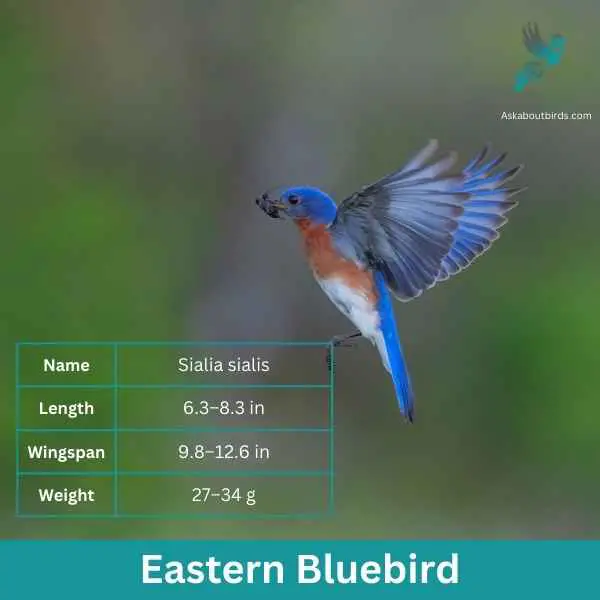
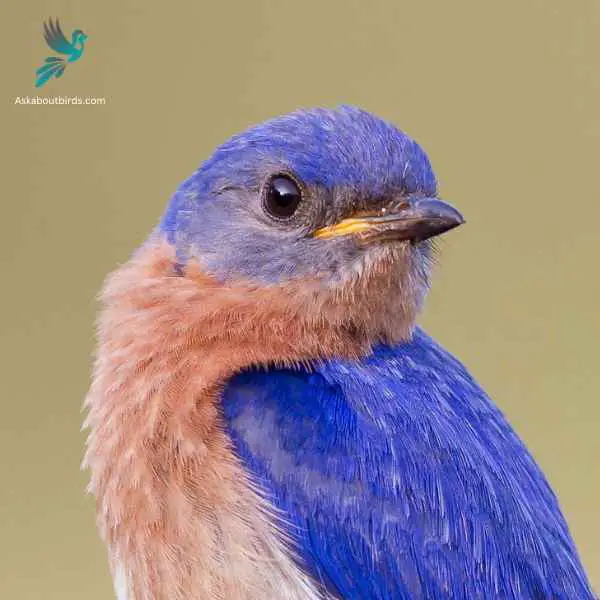
| Feature | Measurement |
|---|---|
| Scientific Name | Sialia sialis |
| Length | 6.3–8.3 in |
| Wingspan | 9.8–12.6 in |
| Weight | 27–34 g |
The Eastern Bluebird (Sialia sialis) is a small thrush found in open woodlands, farmlands, and orchards, and is recognized for its vibrant blue and red coloration. Male Eastern Bluebirds are dazzling with bright blue upperparts and a rusty or brick-red throat and breast, while females, though less colorful, still offer a similar pattern. The bird is native to North America and is commonly seen east of the Rockies, from Canada to the Gulf States and southeastern Arizona to Nicaragua.
Eastern Bluebirds feed on insects, wild fruit and berries. They have a gentle nature and are often seen perched alone or in small groups in the open, scanning the ground for prey. They are cavity nesters and will use old woodpecker holes or birdhouses if they are the right size.
Indigo Bunting


| Feature | Measurement |
|---|---|
| Scientific Name | Passerina cyanea |
| Length | 4.5–5.1 in |
| Wingspan | 7.1–9.1 in |
| Weight | 11.2–21.4 g |
The Indigo Bunting is a strikingly vibrant songbird, often hailed for its brilliant blue plumage and melodic song that graces woodlands and meadows during the warmer months.
Appearance: Males are renowned for their bright indigo blue feathers, which can appear darker in certain lights. Females and juveniles, on the other hand, are brown with subtle hints of blue on their wings and tail. The species lacks the vibrant streaking or spotting commonly found in many other songbirds.
Diet: Indigo Buntings primarily subsist on seeds, especially during non-breeding seasons. During the breeding season, they also consume a variety of insects such as beetles, caterpillars, and spiders, providing essential protein for their growing chicks.
Reproduction: Indigo Buntings build their nests close to the ground in shrubs or low tree branches. These nests, crafted meticulously with grasses and other plant materials, cradle clutches of typically 3 to 4 eggs. After hatching, the young are fed by both parents until they’re ready to fledge.
Blue Jay

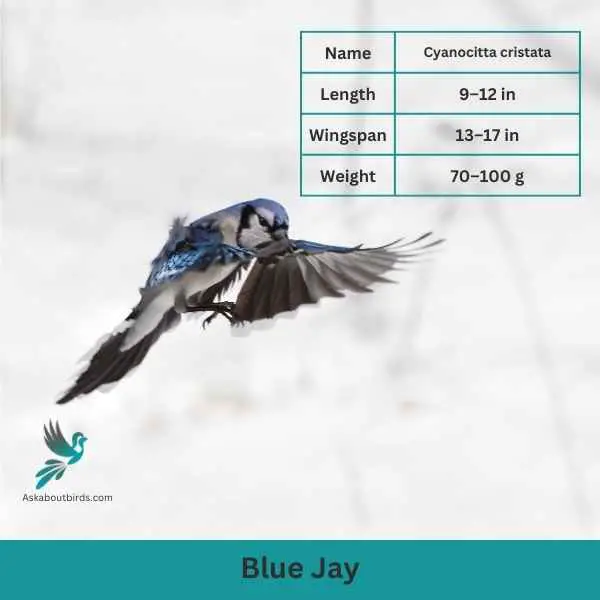
| Feature | Measurement |
|---|---|
| Scientific Name | Cyanocitta cristata |
| Length | 9–12 in |
| Wingspan | 13–17 in |
| Weight | 70–100 g |
The Blue Jay is a vibrant and easily recognized bird, known for its intelligence, distinctive calls, and bold behavior, commonly found throughout the eastern and central United States.
Appearance: The Blue Jay sports a striking blue upper body with white and black markings. Its face has a pronounced white patch with a black necklace that runs across the throat and around the head. The bird also features a pronounced blue crest, which can be raised or lowered, and its wings and tail are brightly colored with black bars and white tips.
Diet: Blue Jays are omnivores. Their diet consists primarily of seeds, nuts, especially acorns, fruits, and small insects. They’ve also been known to eat eggs or nestlings of other birds occasionally. Blue Jays often store food items in caches to eat later.
Reproduction: Blue Jays are monogamous birds that form long-lasting pair bonds. They typically build their nests in trees or large shrubs, constructing them from twigs, grass, and sometimes using mud as a binder. The female lays a clutch of 3 to 6 eggs, which are pale blue or sometimes white with brown speckles.
Blue Grosbeak
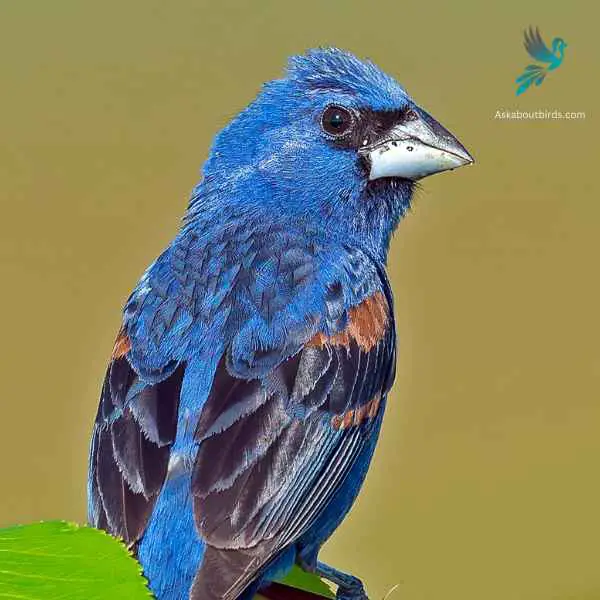

| Feature | Measurement |
|---|---|
| Scientific Name | Passerina caerulea |
| Length | 5.5 to 7.5 in |
| Wingspan | 10 to 11 in |
| Weight | 26 to 31.5 g |
The Blue Grosbeak is a medium-sized songbird found in North and Central America. The male Blue Grosbeak displays stunning plumage with deep blue feathers on its body and head, while the female has more subdued brownish tones. Both sexes have a thick, conical bill, which gives them their name “grosbeak,” meaning large beak.
These birds prefer open habitats such as grasslands, brushy areas, and woodland edges. Blue Grosbeaks are known for their melodious songs, which consist of a series of rich and varied notes. They primarily feed on seeds and insects, using their strong beaks to crack open seeds and forage on the ground or in low vegetation.
Cerulean Warbler
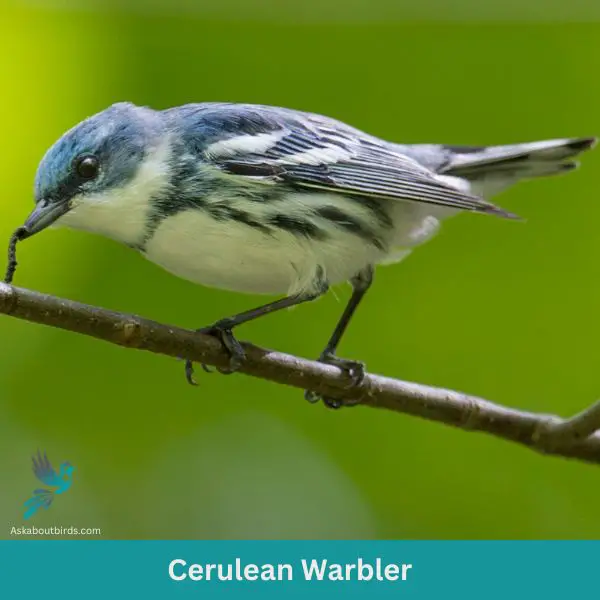
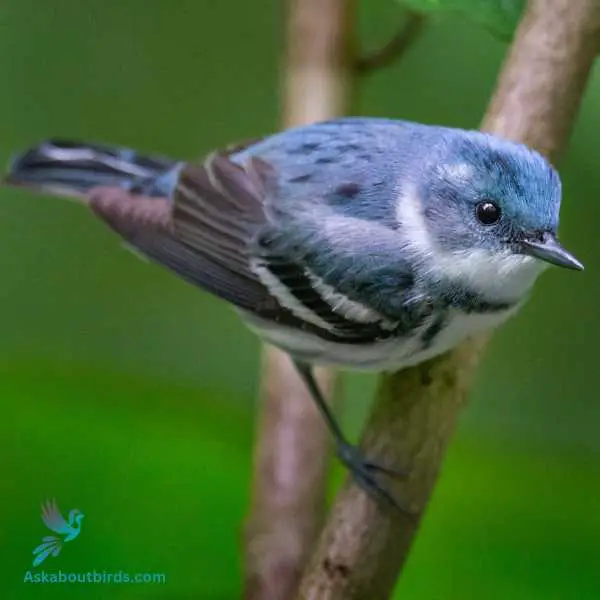
| Trait | Cerulean Warbler |
|---|---|
| Scientific Name | Setophaga cerulea |
| Length | 4.5 inches |
| Wingspan | 7.9-8.7 inches |
| Weight | 0.3-0.4 ounces |
The Cerulean Warbler is a striking songbird known for its sky-blue plumage and flitting movements in the forest canopy.
Appearance: Males boast a vibrant cerulean blue color on their upperparts, with streaked underparts, and a black necklace. Females have a more subdued bluish-green hue and lack the prominent black markings seen in males.
Diet: The diet of the Cerulean Warbler is predominantly made up of insects and spiders. They actively forage high in the treetops, gracefully maneuvering through leaves and branches.
Reproduction: Cerulean Warblers nest in the upper branches of tall deciduous trees. The female weaves a shallow cup-shaped nest and lays a clutch of 3-5 eggs.
Black-throated Blue Warbler

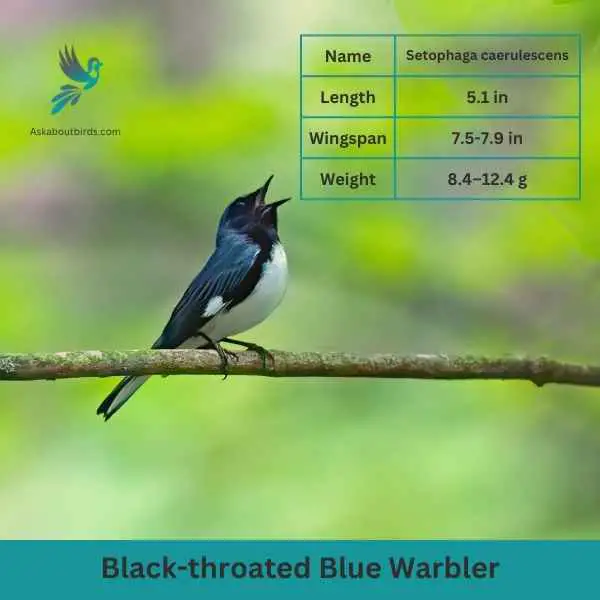
| Feature | Measurement |
|---|---|
| Scientific Name | Setophaga caerulescens |
| Length | 5.1 in |
| Wingspan | 7.5-7.9 in |
| Weight | 8.4–12.4 g |
The Black-throated Blue Warbler is a small migratory bird that breeds in the eastern United States and parts of Canada. The male Black-throated Blue Warbler displays a striking appearance with deep blue plumage on its upperparts, contrasting sharply with a black throat and a white belly. Females, on the other hand, have more muted colors, featuring grayish-olive plumage with a lighter throat.
These warblers prefer deciduous and mixed woodlands, where they forage actively for insects and spiders. They have a slender bill, which they use to extract prey from foliage and tree bark. During the breeding season, males perform courtship displays, showcasing their vibrant plumage and singing a high-pitched song to attract mates.
Black-throated Blue Warblers are known for their long-distance migration. They spend their winters in the Caribbean and Central America, where they inhabit various forested habitats. They construct cup-shaped nests in trees or shrubs, often placing them close to the ground.
Blue-winged Warbler
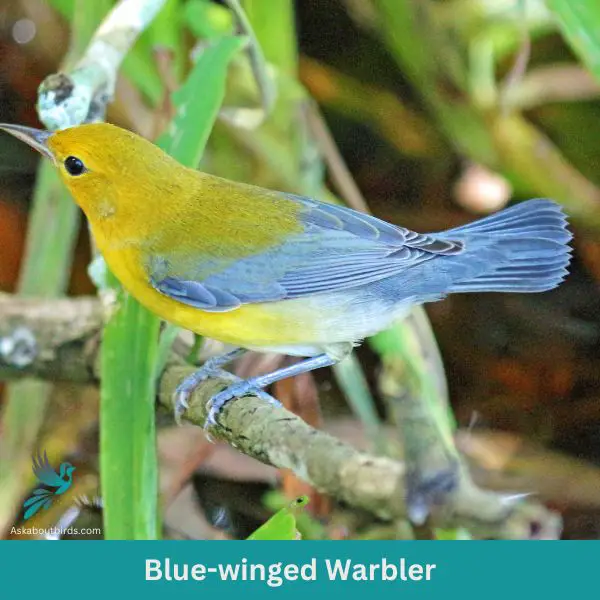
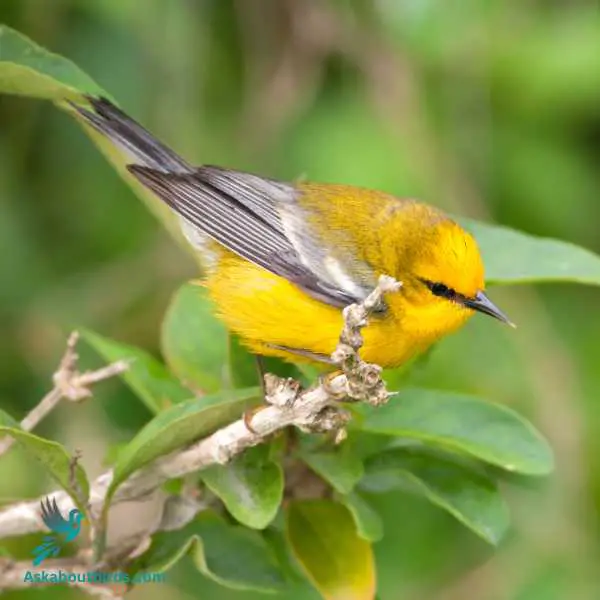
| Trait | Blue-winged Warbler |
|---|---|
| Scientific Name | Vermivora cyanoptera |
| Length | 4.3-4.7 inches |
| Wingspan | 6.7-7.5 inches |
| Weight | 0.3-0.4 ounces |
The Blue-winged Warbler is a vibrant songbird that stands out with its lemon-yellow coloring and buzzing song.
Appearance: This warbler displays a brilliant yellow body contrasted by blue-gray wings and a slim, black line through the eyes. The wings also feature two white wing bars.
Diet: The diet of the Blue-winged Warbler primarily consists of insects and spiders. They actively forage in shrubs and low trees, picking off their prey from the foliage.
Reproduction: Blue-winged Warblers build their nests on or near the ground, using grasses and other fine materials. The female lays a clutch of 4-6 eggs, which she incubates.
Blue-gray Gnatcatcher
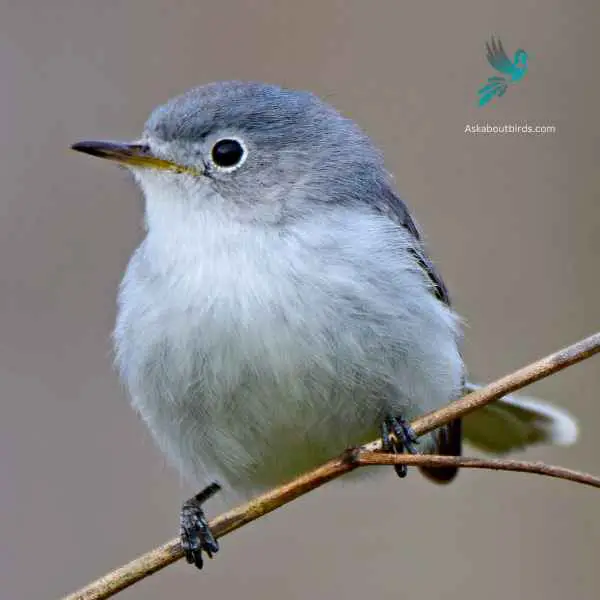
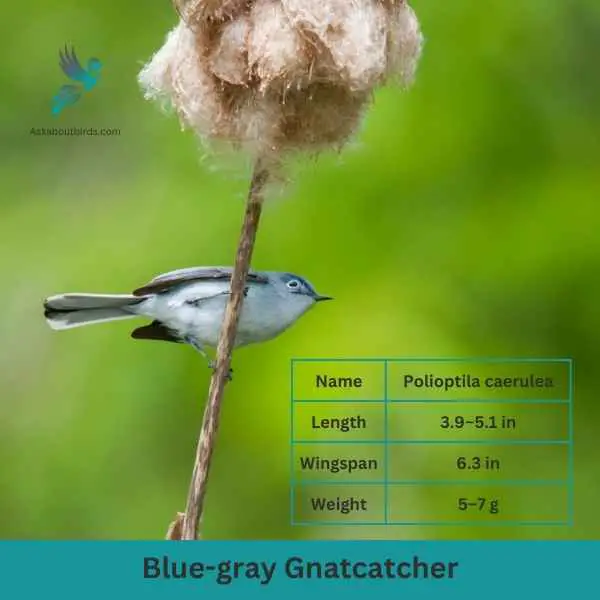
| Feature | Measurement |
|---|---|
| Scientific Name | Polioptila caerulea |
| Length | 3.9–5.1 in |
| Wingspan | 6.3 in |
| Weight | 5–7 g |
The Blue-gray Gnatcatcher is a petite, active bird, frequently observed flitting about treetops, emitting its distinctive high-pitched calls as it moves agilely through the branches.
Appearance: This bird exhibits a predominantly blue-gray plumage with a subtle white eye ring and long, slender tail feathers. The tail has distinctive black and white edging, with the males sometimes showing a faint black line on their forehead during the breeding season.
Diet: Blue-gray Gnatcatchers primarily feed on small insects and spiders. They’re adept hunters, foraging actively among foliage and even catching insects in mid-air.
Reproduction: These birds weave compact, cup-shaped nests on tree branches using plant materials, spider webs, and lichen. The exterior of the nest often matches the tree bark, making it well camouflaged. Inside, the female lays a clutch of 3 to 5 blue or greenish eggs, which she incubates.
Northern Parula
Scientific Name: Setophaga americana
Length: 4.3-4.7 in (11-12 cm)
Wingspan: 6.3-7.1 in (16-18 cm)
Weight: 0.2-0.4 oz (5-11 g)
The Northern Parula is a small, colorful warbler with a distinctive yellow throat and chestnut patch on its back.
Appearance: Both male and female Northern Parulas are similar in appearance, featuring a blue-gray upperpart, a yellowish throat and chest, a white belly, and a distinctive chestnut patch on the back. Males are generally brighter in color than females.
Diet: The diet of the Northern Parula primarily consists of insects and spiders, although they will also consume berries and nectar during certain seasons.
Reproduction: Northern Parulas nest in hanging vegetation, often using Spanish moss or usnea lichen. The female builds the nest and lays a clutch of 4 to 5 white eggs, speckled with brown. The female incubates the eggs and takes the lead in feeding the chicks, although the male may assist in feeding as well.
Tree Swallow
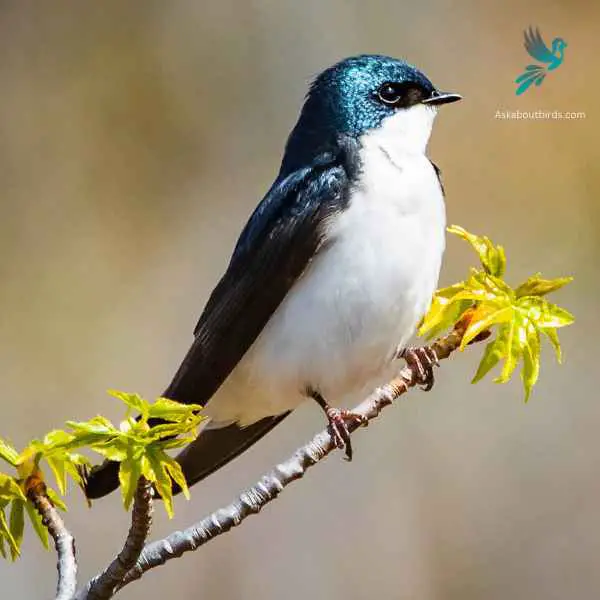
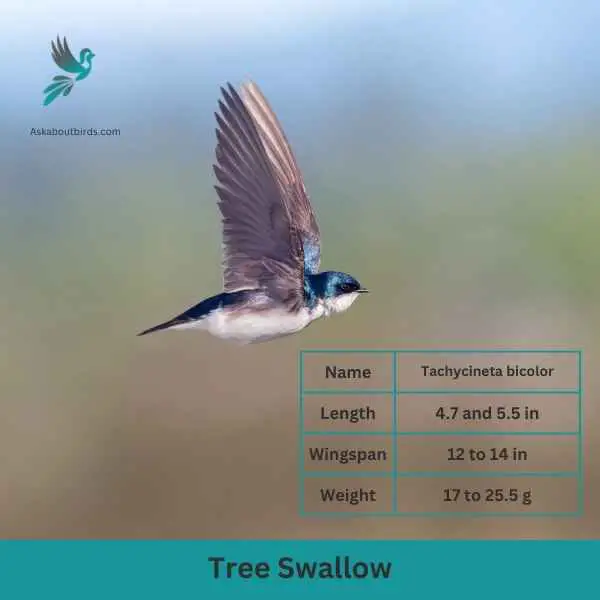
| Feature | Measurement |
|---|---|
| Scientific Name | Tachycineta bicolor |
| Length | 4.7 and 5.5 in |
| Wingspan | 12 to 14 in |
| Weight | 17 to 25.5 g |
The Tree Swallow is a graceful and agile bird, best recognized for its iridescent blue-green upperparts and sweeping flight patterns over open fields and water.
Appearance: The Tree Swallow is sleek with a streamlined body. The upperparts shine with a blue-green iridescence while the underparts are white. They possess long, pointed wings and a slightly forked tail, aiding in their agile flight.
Diet: Tree Swallows primarily feed on flying insects, skillfully catching them mid-air. During colder months when insects are scarce, they can switch to a diet of berries, particularly those of the bayberry, which other birds might find hard to digest.
Reproduction: Tree Swallows are cavity-nesters, typically choosing natural holes in trees or using bird boxes. They line their nests with feathers, creating a soft environment for the eggs. The female will lay a clutch of 4 to 7 white eggs.
Barn Swallow


| Feature | Measurement |
|---|---|
| Scientific Name | Hirundo rustica |
| Length | 6.5–7.5 in |
| Wingspan | 12.5–13.5 in |
| Weight | 16–22 g |
The Barn Swallow is a sleek, agile bird renowned for its graceful flight patterns and iconic forked tail, often seen darting over fields and water bodies in search of flying insects.
Appearance: Barn Swallows have deep blue, almost iridescent, upperparts and a rufous to tawny underbelly. Their distinctively forked tail and long wings give them a streamlined look. Both males and females have a similar appearance, though males often exhibit slightly brighter colors and a deeper fork in the tail.
Diet: Barn Swallows feed primarily on flying insects, which they catch in mid-air during their agile and acrobatic flights. Their diet includes flies, beetles, moths, and other small flying insects.
Reproduction: Barn Swallows are known for building their mud nests on man-made structures, particularly barns, bridges, and eaves. The nest is cup-shaped and made from mud pellets, often lined with feathers. The female lays a clutch of 4 to 6 eggs.
Belted Kingfisher

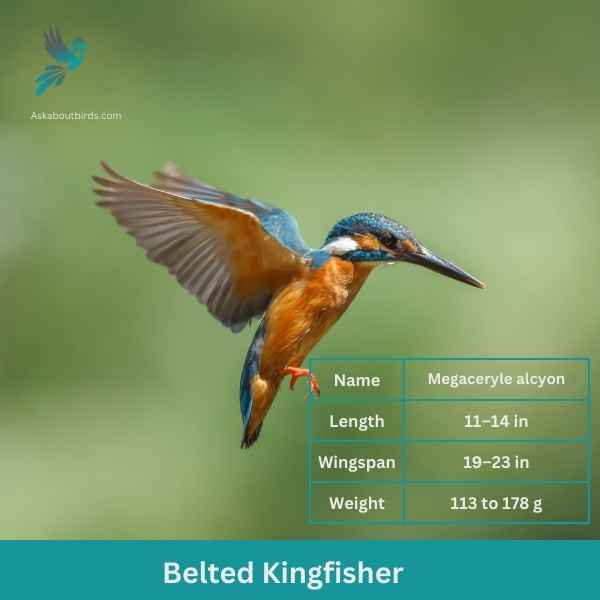
| Feature | Measurement |
|---|---|
| Scientific Name | Megaceryle alcyon |
| Length | 11–14 in |
| Wingspan | 19–23 in |
| Weight | 113 to 178 g |
The Belted Kingfisher is a distinctive and easily recognizable bird, frequently observed near water bodies, where it can be seen diving headfirst to catch prey.
Appearance: Sporting a prominent crest, the Belted Kingfisher has a slate blue-gray upper body and white underparts. Males possess a single blue band across their white chests, while females have an additional rufous band, making them one of the few bird species where females are more brightly colored than males. Their bill is long, sharp, and dagger-like.
Diet: As expert fishers, Belted Kingfishers mainly prey on small fish, but they’ll also consume crustaceans, insects, and amphibians. They’re known for their hunting tactic of hovering over water, spotting their prey, and then diving swiftly to snatch it.
Reproduction: Belted Kingfishers nest in burrows which they excavate in sandy or earthen banks, usually adjacent to water. The tunnel can be anywhere from 3 to 6 feet long, ending in a chamber. Within this chamber, the female lays a clutch of 5 to 8 white eggs.
Where to Spot New Jersey’s Blue Birds
New Jersey is a bird watcher’s paradise, thanks to its diverse habitats and strategic location on the Atlantic Flyway. Here are some top spots for bird watching, especially for those keen on spotting blue birds:
- Cape May Point State Park: Known as one of the best bird-watching spots in North America, Cape May Point State Park is a must-visit location for bird enthusiasts. The park is home to a variety of habitats, making it an ideal spot to see a wide range of bird species, including blue birds.
- Great Swamp National Wildlife Refuge: Located in Morris County, this 7,768-acre refuge offers a variety of habitats, from marshes to forests, that attract a diverse array of bird species. It’s an excellent spot to see blue birds, especially during the spring and fall migrations.
- Edwin B. Forsythe National Wildlife Refuge: This refuge, located in southern New Jersey, provides habitat for more than 250 bird species. The mix of tidal salt marsh, fields, and woodlands make it a great spot to see a variety of birds, including blue birds.
- Sandy Hook Gateway National Recreation Area: Sandy Hook is a prime spot for bird watching, particularly during the migration seasons. The area’s mix of marine, estuarine, freshwater, and terrestrial habitats attract a wide variety of bird species, including several types of blue birds.
- The New Jersey Audubon’s Scherman Hoffman Wildlife Sanctuary: Located in Bernardsville, this sanctuary features a variety of habitats, from hardwood forests to fields and wetlands, making it an ideal location to spot a wide range of bird species, including blue birds.
| Neighboring States | Best Spots for Blue Birds |
|---|---|
| New York’s Blue Birds | 1. Central Park, New York City 2. Montezuma National Wildlife Refuge 3. Jamaica Bay Wildlife Refuge |
| Pennsylvania’s Blue Birds | 1. John Heinz National Wildlife Refuge at Tinicum 2. Hawk Mountain Sanctuary 3. Presque Isle State Park |
| Delaware’s Blue Birds | 1. Bombay Hook National Wildlife Refuge 2. Prime Hook National Wildlife Refuge 3. Cape Henlopen State Park |
FAQs on Blue Bird Species Found in New Jersey
How can I protect bluebird boxes from predators?
Predator guards are essential to protect bluebird boxes from predators like snakes, raccoons, and cats. Install a metal or PVC pipe around the mounting post of the nest box, which will make it difficult for predators to climb up. Additionally, placing the nest box on a metal post rather than a wooden one can also deter predators. Regularly monitoring the nest boxes can also help in identifying and addressing any predator-related issues promptly.
What is the role of the New Jersey Bluebird Society?
The New Jersey Bluebird Society is a non-profit organization dedicated to the conservation of the Eastern Bluebird and other native cavity-nesting birds. Their activities include educating the public about bluebirds, their habitat needs, and how to provide proper nest boxes. They also monitor and manage bluebird trails, conduct field trips and workshops, and work towards the conservation of bluebirds and their habitats.
How does habitat loss affect the nesting of Eastern Bluebirds?
Habitat loss is a significant threat to Eastern Bluebirds as they prefer open areas with scattered trees for nesting. Urbanization, deforestation, and conversion of open spaces into agricultural land have led to a decline in suitable nesting habitats for bluebirds. This not only reduces the number of available nesting sites but also increases competition with other cavity-nesting birds like house sparrows, leading to a decline in bluebird populations. Providing nest boxes in suitable habitats can help mitigate this issue.
How can I help the Purple Martin population?
Purple Martins, the largest swallows in North America, face several challenges including habitat loss, competition from aggressive non-native birds like European Starlings and House Sparrows, and predation. To help these blue beauties, consider setting up specialized Purple Martin houses or gourds in open areas near water. These birdhouses should have multiple compartments as Purple Martins are colonial nesters. Regularly monitor the birdhouses to ensure they are not being occupied by non-native species. Also, consider participating in citizen science programs organized by institutions such as the Cornell Lab of Ornithology or the National Audubon Society, which help in monitoring and conserving Purple Martin populations.
